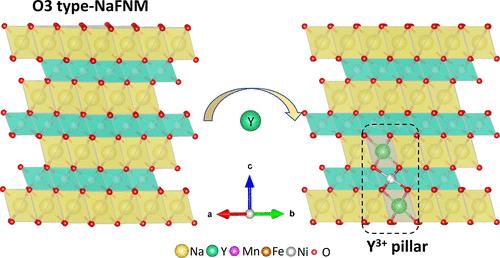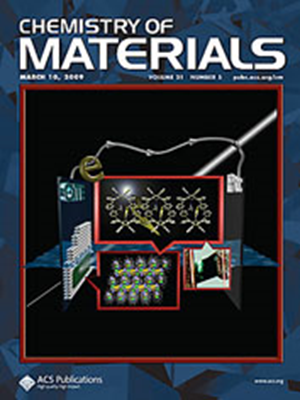Structural Stabilization and Superior Electrochemical Performance of Yttrium-Doped O3-NaFe0.4Ni0.3Mn0.3O2 Cathodes for Sodium-Ion Batteries
IF 7.2
2区 材料科学
Q2 CHEMISTRY, PHYSICAL
引用次数: 0
Abstract
This is the first demonstration of successful Y3+ doping, and Y3+-doped O3-NaFe0.4Ni0.3Mn0.3O2 (NaFNM) cathodes exhibit superior cyclability and C-rate capabilities. Y3+ doping enabled cells with 91% capacity retention at 1 C after 100 cycles and a high specific capacity of 102 mA h g–1 at a 7 C rate. Furthermore, the full cell delivered outstanding cycling stability, with a capacity retention of 80% after 500 cycles at 1 C and 71.3% after 1000 cycles. Operando X-ray diffraction spectroscopy (XRD) and X-ray absorption spectroscopy, along with simulations using density functional theory and neural network potential methods, provided comprehensive insights on the effects of Y3+ doping on the cycling characteristics. Our results confirm that Y3+ doping effectively stabilizes the O3 structure, enhances the electrochemical performance, and addresses the challenge of irreversible O3 to P3 phase transitions.

钠离子电池用掺钇O3-NaFe0.4Ni0.3Mn0.3O2阴极的结构稳定性和优异的电化学性能
这是Y3+掺杂的首次成功证明,Y3+掺杂的O3-NaFe0.4Ni0.3Mn0.3O2 (NaFNM)阴极表现出优异的循环性和c -速率能力。Y3+的掺杂使电池在1℃循环100次后容量保持91%,在7℃速率下的比容量高达102 mA h g-1。此外,完整的电池具有出色的循环稳定性,在1c下循环500次后容量保留率为80%,循环1000次后容量保留率为71.3%。Operando x射线衍射光谱(XRD)和x射线吸收光谱,以及密度泛函理论和神经网络势方法的模拟,为Y3+掺杂对循环特性的影响提供了全面的认识。我们的研究结果证实,Y3+的掺杂有效地稳定了O3的结构,提高了电化学性能,解决了O3向P3相变不可逆的挑战。
本文章由计算机程序翻译,如有差异,请以英文原文为准。
求助全文
约1分钟内获得全文
求助全文
来源期刊

Chemistry of Materials
工程技术-材料科学:综合
CiteScore
14.10
自引率
5.80%
发文量
929
审稿时长
1.5 months
期刊介绍:
The journal Chemistry of Materials focuses on publishing original research at the intersection of materials science and chemistry. The studies published in the journal involve chemistry as a prominent component and explore topics such as the design, synthesis, characterization, processing, understanding, and application of functional or potentially functional materials. The journal covers various areas of interest, including inorganic and organic solid-state chemistry, nanomaterials, biomaterials, thin films and polymers, and composite/hybrid materials. The journal particularly seeks papers that highlight the creation or development of innovative materials with novel optical, electrical, magnetic, catalytic, or mechanical properties. It is essential that manuscripts on these topics have a primary focus on the chemistry of materials and represent a significant advancement compared to prior research. Before external reviews are sought, submitted manuscripts undergo a review process by a minimum of two editors to ensure their appropriateness for the journal and the presence of sufficient evidence of a significant advance that will be of broad interest to the materials chemistry community.
 求助内容:
求助内容: 应助结果提醒方式:
应助结果提醒方式:


